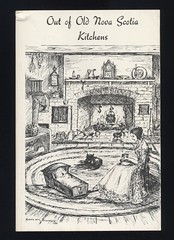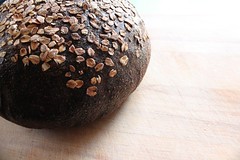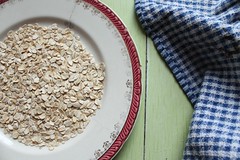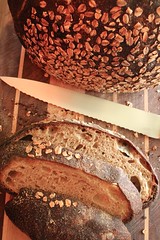You can't always get what you want...
 fig. a: Old Nova Scotia
fig. a: Old Nova Scotia
A few weeks I got caught up in a small-scale research project of sorts.
A friend of mine, S., was on the lookout for Nova Scotia-style brown bread. S. hails from New Scotland, and she had a hankering for a taste from home. She thought there must be somewhere in Montreal that baked or offered Maritimes-style brown bread, but I wasn't so sure. After all, it's nearly impossible to get loaves that have deep roots in Montreal--like a true caraway rye--let alone loaves from beyond Quebec, and especially loaves from other provinces.
Now, at first I thought she had something along the lines of Boston brown bread in mind. S. had mentioned molasses and I was fairly certain that steamed brown bread could be found in the Maritimes, too. I was right about that,* but it turned out she had a more conventional baked bread in mind, one that came topped with rolled oats.
All of a sudden, I could picture it. This Maritimes-style brown bread was definitely something I'd seen in New Brunswick and Prince Edward Island a few years ago. In fact, I was convinced I'd tasted it, too. And I was pretty sure I could smell its sweet, homey aroma.
Now, as it turns out, I'd been on something of a molasses kick in my bread baking. For a few months, a good percentage of the loaves I'd made on my weekly adventures in baking were either corn rye or Danish rye loaves, both of which featured the lovely rounded flavours of molasses. So I decided to take up the quest for Nova Scotia-style brown bread as a challenge, and I told S. I was doing so. My only caveat was that, no matter what I discovered, I was going to develop a sourdough version of brown bread.
Now, that might sound a little ungenerous, but I was fairly certain that at some point in the past, sometime before the advent of industrialized yeast, Nova Scotia brown bread had been made with sourdough starter. S. is a historian--I was hoping she'd understand.
When I began to research Nova Scotia brown bread online, I became even more set in my ways. It might just have been the quality of the photographs in question, but I wasn't crazy about the kinds of recipes I was finding--or the way the results of those recipes looked.
Well, it turns out I was wrong, or, at least, the predominant method for baking Nova Scotia brown bread was altogether different from what I'd imagined. Apparently, traditional bread baking in the Maritimes had been accomplished with homemade yeast.
As Marie Nightingale explains in our copy of Out of Old Nova Scotia Kitchens:
For the wise mother who still insists that home-made bread is a necessity for her family's health and enjoyment, bread-making is an easy task as compared to that of earlier days. Today we begin with prepared yeast, either in cake or granular form, but in the old days the yeast had first to be made before thought could be given to making bread.
Making the yeast starter from hops and potatoes was a process that involved days, so care had to be taken to keep a supply always on hand. Kept tightly corked in stone jars and stored in a cool place, the yeast would stay sweet and fresh for a couple of months.As intrigued as I was by the idea of making homemade yeast, I had a sourdough starter on hand, and it was definitely sweet and fresh, so I stuck to my plan. And, basically, I used this project as an excuse to overhaul my whole wheat bread recipe, which I'd always found a little ascetic.
This is what I came up with:
 fig. b: is for brown & bread
fig. b: is for brown & breadAEB Brown Bread
200 grams leaven (20%)
630 grams water (80º F, ideally) + an additional 50 grams of warm water (68%)
100 grams fancy molasses (10%)
[total hydration: 780 grams (78%), including the molasses]
600 grams whole wheat bread flour (60%)
400 grams AP flour (40%)
[total flour: 1 kg (100%)]
20 grams kosher salt (2%)
rolled oats (as needed)
Notes: Top each loaf with untoasted rolled oats before the final rise. I don't bother slashing my loaves before I bake them, as the topping of rolled oats makes this too difficult. I just let these loaves go freeform.
 fig. c: rolled oats
fig. c: rolled oatsI've mentioned this before, but my sourdough method is borrowed directly from Chad Robertson's from Tartine Bread. For optimum results, you should follow his directions closely. Here, I'm just providing the measurements (in weight) and baker's percentages that you need to make two large loaves (roughly 2 pounds each).
Anyway, I was pretty thrilled with the results.
 fig. d: sliced bread
fig. d: sliced breadIn fact, this brown bread instantly became our house favourite, a loaf that made particularly great sandwiches, not to mention a loaf that had us bolting out of bed in the morning (well, at least it had me bolting out of bed in the morning) to make toasts with only butter on them. Nothing else is needed. Except maybe a soft-boiled egg.
Or possibly the occasional drizzle of honey, but somehow that usually seems like gilding the lily to me.
S. liked it, too. Because, of course, as soon as I tested it, I invited S. and J. over for dinner and baked her her very own loaf. Nova Scotian verdict: "super tasty!"
I took that to mean success. But mostly I saw it as another example of how you can't always get what you want, but if you try sometime, well, you just might find you get what you need. We certainly did.
aj
* Steamed Brown Bread shows up sixth in Out of Old Nova Scotia Kitchens' section on Breads, after Anadama Bread, Rolled Oats Bread (one of the inspirations here), French Bread, Salt Rising Bread, and Sally Lunns.


No comments:
Post a Comment